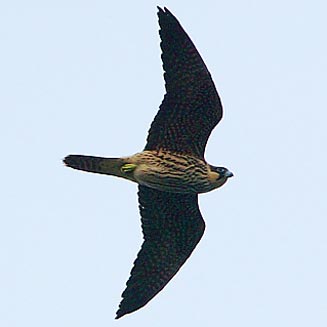|
Falco eleonorae (Eleonora's
falcon)
Eleonoravalk [Afrikaans]; Eleonora-valk [Dutch]; Faucon
d'Éléonore [French]; Eleonorenfalke [German]; Falcão-da-rainha [Portuguese]
Life
> Eukaryotes >
Opisthokonta
> Metazoa (animals) >
Bilateria >
Deuterostomia > Chordata >
Craniata > Vertebrata (vertebrates) > Gnathostomata (jawed
vertebrates) > Teleostomi (teleost fish) > Osteichthyes (bony fish) > Class:
Sarcopterygii (lobe-finned
fish) > Stegocephalia (terrestrial
vertebrates) > Tetrapoda
(four-legged vertebrates) > Reptiliomorpha > Amniota >
Reptilia (reptiles) >
Romeriida > Diapsida > Archosauromorpha > Archosauria >
Dinosauria
(dinosaurs) > Saurischia > Theropoda (bipedal predatory dinosaurs) >
Coelurosauria > Maniraptora > Aves
(birds) > Order: Falconiformes >
Family: Falconidae
 |
|
|
Eleonora's falcon, Formentor peninsula, Mallorca,
Spain. [photo Steve Garvie
©] |
|
Distribution and habitat
Breeds in the Mediterranean region, from Morocco and Canary
Island to Cyprus, heading south in the breeding season to Madagascar and
north-eastern Africa. It is a
vagrant to southern Africa, with records in north-western and eastern
Zimbabwe, coastal Mozambique, the Western Cape and KwaZulu-Natal. It generally
prefers moist, forested or well-wooded areas, even if they are partially cleared for
agriculture.
References
-
Hockey PAR, Dean WRJ and Ryan PG 2005. Roberts
- Birds of southern Africa, VIIth ed. The Trustees of the John Voelcker
Bird Book Fund, Cape Town.
|
